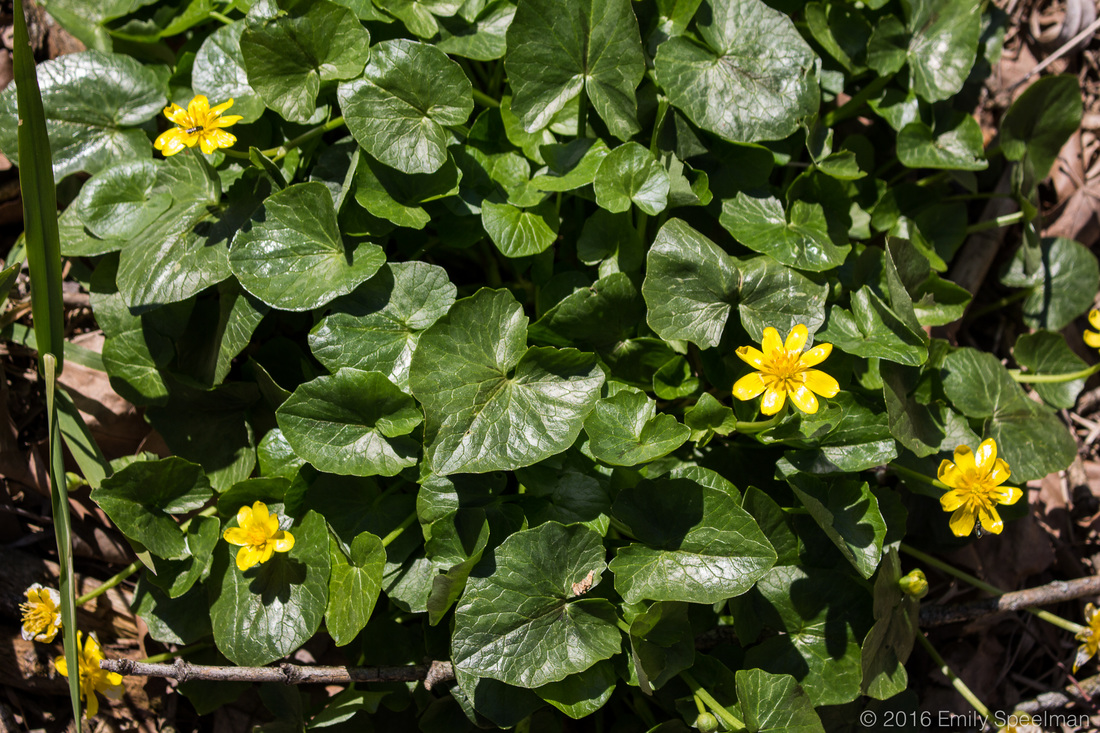|
Along with knowing what all the beautiful native wildflowers are this spring, it's also important to know the invasive and damaging species (lesser celandine, garlic mustard, some honeysuckle species, japanese hops, etc) and how/when to remove them. These species are known to do damage to the surrounding plants as well as pose a threat to the native wildlife. Lesser Celandine can be found in open woods, waste areas, meadows, and floodplains preferring sandy soil. It closely resembles the Marsh Marigold and is often misidentified as such.
To tell the difference between the two it's important to know the native Marsh Marigold has only 5-9 petals where as the Lesser Celandine has 8-12, and the leaves of the Marsh Marigold are round sometimes kidney shaped where as the Lesser Celandine which has more of a heart shape. Marsh Marigolds tend to stay in small bunches and do not have the same sort of underground tuber system that the Lesser Celandine have. If left to go it will completely blanket the area displacing many native plant species, especially those with the similar spring-flowering life cycle. Some examples of native spring ephemerals which become choked out by the Lesser Celandine include bloodroot, wild ginger, spring beauty, harbinger-of-spring, twinleaf, squirrel-corn, trout lily, trilliums, Virginia bluebells, and many, many others. These plants provide critical nectar and pollen for native pollinators, and fruits and seeds for other native insects and wildlife species. Because Lesser Celandine emerges well in advance of the native species, it has a developmental advantage which allows it to establish and overtake areas rapidly. How to get rid of this species: First, make 100% sure you have properly identified the right species before you do anything else. Due to the system of underground tubers with which it reproduces, hand-pulling is not recommended (unless you have a trowel and time to dig and pull every tuber along the system). According to the National Park Service: "While manual methods are possible for some (small) infestations, the use of systemic herbicide is more effective because it kills the entire plant including the roots and minimizes soil disturbance. Chemical In order to have the greatest negative impact to celandine and the least impact to desirable native wildflower species, herbicide should be applied in late winter-early spring, generally February through March. Start applications prior to flowering and up until about 50 percent of the plants are in flower, around April 1, then stop. After that, control success declines and many more native wildflowers have emerged that could be killed by spray. Native amphibians would also be emerging and could be harmed. Apply a 1 to 1.5% rate of a 53.8% active ingredient glyphosate isopropylamine salt (e.g., Rodeo® which is labeled for use in wetland areas), mixed with water and a non-ionic surfactant to foliage, avoiding application to anything but the celandine. Glyphosate is systemic; that is, the active ingredient is absorbed by the plant and translocated to the roots, eventually killing the entire plant. The full effect on the plant may take 1-2 weeks. Retreatment the following year will likely be needed. Applications can be made during the winter season as long as the temperature is 50 degrees Fahrenheit or above, and no rain is anticipated for at least 12 hours. Because glyphosate is non-specific, spray should be directed such that it contacts only fig buttercup and does not drift onto desirable native plants. To minimize impacts to sensitive-skinned frogs and salamanders, some experts recommend applying herbicide in March and then switching to manual methods. Manual-Mechanical For small infestations, fig buttercup may be pulled up by hand or dug up using a hand trowel or shovel. It is very important to remove all bulblets and tubers. Due to the abundant tiny bulblets and tubers, all material must be bagged up, removed from the site and disposed properly in a landfill or incinerator. A major consideration when manually removing invasive plants like this is the disturbance to the soil which can encourage the target invasive as well provide openings for invasion by other exotic species. For these reasons, manual and mechanical removal is probably inappropriate for larger infestations in high quality natural areas." (More info from the NPS can be found here https://www.nps.gov/plants/alien/fact/rafi1.htm )
0 Comments
Leave a Reply. |
AboutSince 2015 we have been exploring and sharing all the amazing things we’ve found in nature. AuthorEmily is an Ohio Certified Volunteer Naturalist who is most often found out in the woods. Archives
June 2024
Categories
All
|

 RSS Feed
RSS Feed